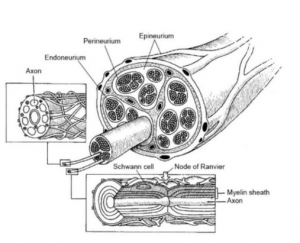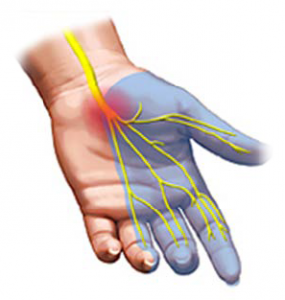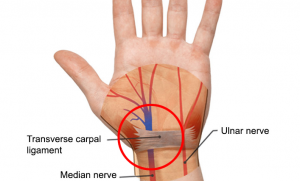Carpal Tunnel Syndrome
What is Carpal Tunnel Syndrome (CTS)?
Carpal Tunnel Syndrome is a compressive neuropathy of the median nerve as it travels through the carpal tunnel at the wrist. A compressive neuropathy is a progressive injury to a nerve caused by constant, unrelenting pressure. The outer covering of the nerve (myelin sheath) which enhances the nerve’s ability to conduct signals is injured due to lack of blood flow. Small nerve fibers, those that conduct light touch and temperature, are affected first. Larger fibers, like those that conduct impulses to muscles, are affected later with ongoing progression.
A compressive neuropathy is progressive: it will result in increasing damage until the nerve no longer functions.
Who gets CTS?
The age-old myth of typing and carpal tunnel syndrome has been disproven. CTS is more likely a disorder of aging.
It is two times more common in women than in men. Tendons an ligaments become less compliant and therefore are less able to tolerate transient swelling (tendonitis) and often can be affected by wrist position while sleeping. If one sleeps with the wrist bent, it can cause irritation and swelling of the nerve, increasing daytime symptoms. People with diabetes, thyroid disorders, rheumatoid arthritis, and obesity are also prone to CTS. CTS can also present as a swelling related complication of pregnancy. CTS is the most common hand-related seen in an orthopedic office.
What are the symptoms of CTS?
Numbness and tingling in the median nerve innervated digits (thumb, index, long and half of the ring) are the most common presenting symptoms. These may present at night time, often waking the sufferer up. Some complain of weakness, loss of dexterity, and a problem with dropping objects. Pain can be present but is inconsistent.
How is CTS diagnosed?
History is the most important way to diagnose CTS. Specific questions and questionnaires have been developed to help aid in diagnosis and to follow the treatment of CTS. A physical examination will help aid in the diagnosis as well as assessing other issues. Sometimes electrodiagnostic studies are ordered. These studies are performed by a physician with specialized training and can help rule out other problems like peripheral nerve disorders, ALS, and other concomitant compressive neuropathies.
How is CTS graded?
CTS is graded mild, moderate, and severe. This correlates with the electrodiagnostic criteria as well as rough clinical guidelines. Mild CTS has no weakness. Moderate CTS can have weakness or motor involvement. Severe CTS has weakness and can have end-stage changes like atrophy of the muscles to the thumb.
How is CTS treated?
Mild CTS is treated with night time splinting and reassessment later to ensure that there has been no progression. Moderate and Severe CTS is relegated to surgical treatment or a carpal tunnel release (CTR). There are large numbers of studies showing no significant long-term benefit from steroid injections, therapy, ultrasound, or any other non-operative treatment. We recently published an article in the Journal of Hand Surgery showing that those with moderate CTS and those with severe CTS can show a predictable improvement. Those with moderate CTS showed better and more consistent results at an earlier time.
Open vs Endoscopic CTS?
There is no proven benefit from endoscopic CTR vs. a mini-open CTR. The only way to treat carpal tunnel is to release the transverse carpal ligament. There is a documented greater chance of recurrence with an endoscopic CTR. This is usually due to an incomplete release of the ligament. We perform a mini-open CTR with local anesthesia. We have found this to be the safest and most predictable procedure for CTS.
“Microinvasive CTR”- There is no such thing as a non-invasive surgical procedure. CTS is a neurologic injury. The consensus for treating it once it has become moderate in severity is to release the transverse carpal ligament. This means to surgically divide the ligament. This takes time to heal. The nerve must re-grow an outer covering (mylean sheath) and the ligament that is cut will repair itself in a lengthened position. Until these things occur, the patient will have symptoms. After surgery, most patients can go back to clerical work in a day or two. They will not be able to do heavy manual labor for about a month.
Return to aggressive activity too early will lead to scar formation instead of healing and may necessitate a bigger surgical procedure.
Outcomes CTR- Carpal Tunnel Release surgery is the most common thing
treated by hand surgeons. Hand surgeons have additional training past a five-year surgical (orthopedic or plastic) residency training. Have confidence in your surgical provider before undergoing this procedure.



